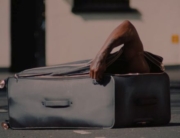
One of the many joys of watching movies regularly is coming across a filmmaker who clearly loves making them. There are many wunderkinds who are very good at the technical act of filmmaking. Simply put, they know how to wow you. Others, like, say, Christopher Nolan or, more recently, Ari Aster’s horror opuses create clever, intricate puzzles for the viewer to untangle. And then there are the folks who make films that leave you giddy, where you can see the talent bursting from the seams, where you can practically hear the filmmakers laugh at the fun of just making them. The Vast of Night is such a movie.
Shot on a very low budget with two leads and a handful of supporting roles, the story centers on two high school students in the tail end of the 1950s: Everett Sloan, a DJ who has the night shift at the local radio station, and Fay Crocker, who works the town’s switchboard at night for extra money. While almost the entire town is at a high school basketball game, Fay hears a weird sound come through the wire and patches it through to Everett, who puts it on the radio to see if anyone knows what it might be. He gets a response which leads to… well… you’ll see.
Rarely has a debut film attacked its subject matter with such energy and verve. At the start, the camera restlessly follows Everett and Fay as they get to know each other. (They shoot lines at each other as if they are in a high school screwball comedy.) At times, the camera prowls behind the actors’ feet or trails behind them as they head down the road, as if it, like us, is desperate to catch up.
Once the film settles down, we are in for long, unbroken close-ups as each listens to the stories of where the sound is coming from. The confidence that director Andrew Patterson has in these young actors is well placed. As Everett, Jake Horowitz oozes charisma as he tries on a confident fast-talking McConaughey persona, replacing the oily confidence with a nerdy enthusiasm.
Sierra McCormick’s an equally important find as Fay, a science fanatic who is smart and responsible, but when there’s an opportunity to break the rules, just a little bit, a charge surges through her. Earlier when she tells Everett she wants to go to college, she shoots down his suggestion that she should, because she’s a realist. She’s poor, and she needs to provide for her single mom. It doesn’t matter how talented she is. She knows her life trajectory, so this little adventure takes much greater significance for her.
Patterson obviously worships at the altar of Spielberg (with a dash of the underrated Joe Dante thrown in), but his eye is on the gee-whiz early Spielberg of Duel and Jaws and E.T. His heroes are nerds, but they move through their environment naturally and with ease. Everyone treats them with respect. In this small southern New Mexico town, everyone is open-faced and not sour. The threat is external. There is also the awe of the unknown and the facing of that unknown that infuses early Spielberg.
The feeling of watching Patterson’s film is similar. He knows when to quicken or slow down the pace, when to let us in up close, and when to let us observe the teens. He charges ahead with the narrative, assuming his breathless enthusiasm is enough for you to want to go crashing through the undergrowth with him. Additionally, the camerawork and other technical aspects are simply superb.
The plot is nothing special. It’s fairly recycled sci-fi, and it knows it. The film posits itself as an episode of an old-fashioned Twilight Zone knockoff, but its strength isn’t its plot, it’s the skill and enthusiasm this team of filmmakers manages to create with the thinnest of stories and the smallest of budgets. The fact they succeed in making something so wildly entertaining is a testament to their skill and a harbinger to their future.
















Leave A Comment